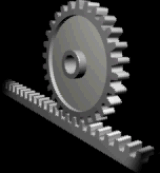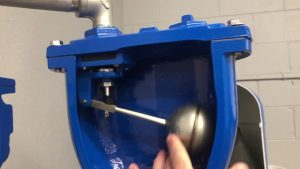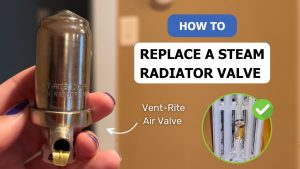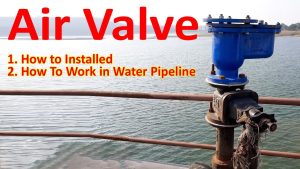Three primary kinds of valve actuators are commonly used: pneumatic, hydraulic, and electric.
Pneumatic actuators can be further categorized as scotch yoke design, vane design, and the subject of this post-rack and pinion actuators.
What is a Rack and Pinion actuator?
Rack and pinion actuators are mechanical devices used to automatically open and close valves or dampers, usually for industrial applications.
Rack-and-pinion pneumatic actuators, also called limited rotation cylinders, are rotary actuators used for turning, opening, closing, mixing, oscillating, positioning, steering and many more mechanical functions involving restricted rotation. These actuators are also often used for automation of quarter-turn valves, like ball or butterfly valves.
Pneumatic rack-and-pinion actuators convert the energy of compressed air by means of a pneumatic cylinder to an oscillating rotary motion. The clean, dry, and processed gas required by this actuator is provided via a central compressed air station, which usually supports a range of pneumatic devices in a process system.
Pneumatic actuators, in comparison to their electric counter parts, are generally more durable, better suited for hazardous environments and less expensive. In addition, they often require less maintenance and provide higher torque in comparison to their size.
Rack and pinion actuators convert linear movement of a driving mechanism to provide a rotational movement designed to open and close quarter-turn valves such as ball, butterfly, or plug valves and also for operating industrial or commercial dampers.

The rotational movement of a rack and pinion actuator is accomplished via linear motion and two gears. A circular gear, known as a “pinion” engages the teeth of one or two linear gears, referred to as the “rack”.
Pneumatic actuators use pistons that are attached to the rack. As air or spring power is applied the to pistons, the rack changes position. This linear movement is transferred to the rotary pinion gear (in both directions) providing bi-directional rotation to open and close the connected valve.
Rack and pinion actuators pistons can be pressurized with air, gas, or oil to provide the linear the movement that drives the pinion gear. To rotate the pinion gear in the opposite direction, the air, gas, or oil must be redirected to the other side of the pistons, or use coil springs as the energy source for rotation. Rack and pinion actuators using springs are referred to as “spring-return actuators”. Actuators that rely on opposite side pressurization of the rack are referred to as “direct acting”.
Construction of Rack & Pinion actuator
Most actuators are designed for 100-degree travel with clockwise and counterclockwise travel adjustment for open and closed positions. World standard ISO mounting pad are commonly available to provide ease and flexibility in direct valve installation.
Mounting dimensions on actuator pneumatic port connections and on actuator accessory holes and drive shaft are also common design features to make adding pilot valves and accessories more convenient.
Pneumatic pneumatic rack and pinion actuators are compact and effective. They are reliable, durable and provide good service life. There are many brands of rack and pinion actuators on the market, all with subtle differences in piston seals, shaft seals, spring design and body designs. Some variants are specially designed for very specific operational environments or circumstances.
Indicator
Position indicator is standard for mounting accessories.
Pinion
Pinion is electroless nickel-plated alloy steel for NAMUR mounting of accessories, ISO 5211 and DIN3337 for mounting to valves.
Actuator Body
Extruded hard anodized aluminum allows ASTM6005 body, powder polyester painted. TVC standard is light gray powder polyester paint.
End Caps
Die cast aluminum powder polyester painted in black. Different colors upon request. Also available in PTFE or ENP.
Pistons
The twin rack pistons are made from die cast aluminum then hard anodized. Also available from cast steel and galvanized. The pistons are symmetrically positioned for long cycle life and fast operation. Reversing rotation is simply performed by inverting the pistons.
Travel Adjustment
The two independent external travel stop adjustment bolts can adjust ±5° at both open and close directions easily and precisely.
High-Performance Springs
Preloaded coated springs are made from high-quality material resistant to corrosion and longer service life, which can be changed safely and conveniently to satisfy different requirements of torque by changing the quantity of springs.
Bearings & Guides
Made from low friction, long-life engineered plastics, to avoid direct contact between metals. Maintenance and replacement are easy and convenient.
O-Rings
NBR rubber O-rings provide trouble-free operation at standard temperature ranges. For high- and low-temperature applications FKM or Silicone
How does Rack and Pinion actuator Work?
Double Acting Actuators
Air to Port A forces the pistons outwards, causing the pinion to turn counterclockwise while the air is being exhausted from Port B.
Air to Port B forces the pistons inwards, causing the pinion to turn clockwise while the air is being exhausted from Port A.
Air to Port A forces the pistons outwards, causing the pinion to turn clockwise while the air is being exhausted from Port B.
Air to Port B forces the pistons inwards, causing the pinion to turn counterclockwise while the air is being exhausted from Port A.
Spring Return Actuators
Air to port A forces the pistons outwards, causing the springs to compress, The pinion turns counterclockwise while air is being exhausted from port B.
Loss of air pressure on port A causes the stored energy in the springs to force the pistons inwards. The pinion turns clockwise while air is being exhausted from port A.
Air to Port A forces the pistons outwards, causing the pinion to turn clockwise while the air is being exhausted from Port B.
Loss of air pressure on port A causes the stored energy in the springs to force the pistons inwards. The pinion turns counterclockwise while air is being exhausted from port A.
Common Rack and Pinion Applications
Rack and Pinion actuators are for automation and operation of quarter-turn valves like Butterfly, Ball and Plug valves as used in process industries like chemical, pharmaceutical, water processing, oil & gas, etc.
The actuators are available in two constructions: Spring Return and Double Acting. Mechanical Spring Return is for fail-safe applications and can be assembled for “Fail-Close” or “Fail-Open” safety function.
Double Acting actuators can be used for a “Fail-In-Last-Position” safety function.
Advanced Rack and Pinion Applications
Rack and Pinion actuators are available for a wide range of advanced applications. Most well know are the temperature related trim kits that allow High Temperature or Low Temperature operation.
Other applications are related to manipulating the stroke differently (Full Stroke Adjustment), special coating requirements, special operating media, or fast operating speeds.
For many of these advanced applications, dedicated control accessories are available.
Share your process valve control and automation challenges with application experts, and combine your process experience and knowledge with their product application expertise to develop effective solutions.
Related Tags :
Ten articles before and after
Gate Valve Vs Butterfly Valve Comprehensive Compare Guide
How to Measure Butterfly Valves
What is a Double Offset Butterfly Valve
How to Fix a Leaking Butterfly Valve?
Case Study From CSB: Industrial Plant Heat Exchanger Explosion | Zeco Valve Blog
Floating Ball Valves | Zeco Valve Blog
Trunnion Mount Ball Valves | Zeco Valve Blog
Ergonomic Electro-Pneumatic Valve Positioner | Zeco Valve Blog
Forged Steel Valves for the Toughest Applications | Zeco Valve Blog












